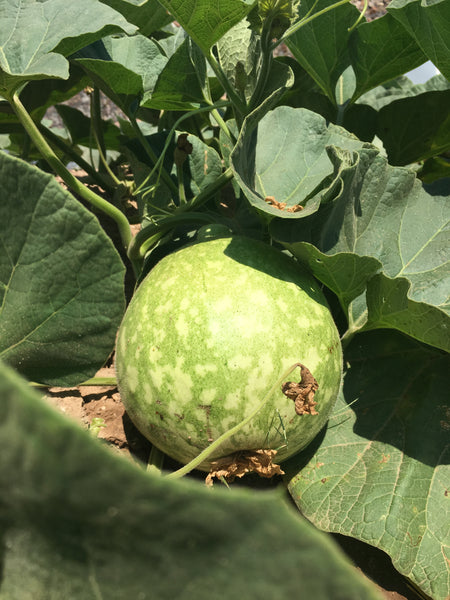
Article by Michelle Langmaid, Americorps VISTA Garden and Volunteer Coordinator, published September 14, 2017.
The NS/S Garden Crew has been very busy this summer, and while we’ve had fun, nobody is going to say it has been easy! Our dedicated, albeit small, group of Garden Volunteers has accomplished a lot despite the summer heat with the help of popsicles, cold coffee, and an indomitable sense of humor.
We raced to complete the construction of a ground squirrel deterring fence before the rains came, and did so with the help of an experienced farmer with an excavator. The trench involved burring hardware cloth at least 1 foot in the ground. Metal flashing was attached to the hardware cloth to prevent squirrels from climbing up the sides of the fencing. We got it done just a few days before the first rain event, and were able to plant a summer growout of Mayo Blusher Squash just in time. We double-dug more sunken beds, amended with 50% compost, and started planting Drum Gourds (part of our Adopt-A-Crop campaign), Tohono O’odham Cowpeas, numerous types of chiles, and Apache Red “Sugarcane” Sorghum.
For the time being, we are in a lull in terms of planting, but there are other tasks, including careful observation, that are moving to the forefront.

Construction of ground squirrel deterring fence.
WATERING
We spend a lot of time talking about water in the garden, and a lot of questions come up that are worth considering. This is such a frequent topic for the obvious reason of having so little of this resource in the Southwest, but it’s also because all of our watering is done by hand. The installation of drip irrigation would likely require at least one of the following: a pump for our cistern, increased dependency on CAP water, or the installation of another large, more strategically placed cistern, all of which come at a price. When you find yourself spending nearly two hours watering the gardens, you start thinking about logistics, civic responsibility, and environmental ethics in real time.
After we planted sorghum in mid-July as a cover crop, it became apparent that we didn’t have enough rainwater stored to support the whole crop. It could be argued that if we had planted the seeds in deeper basins they may have thrived. We’ll try that next time. The point is, we’ve had to recognize that unless we want to rely on CAP water, we’ll have to scale down or grow smarter. These seeds, while drought-tolerant, are not necessarily drought-loving. Finding a balance between watering more than is necessary and keeping them healthy is something we’ve been observing in the garden lately. Instead of trying to keep all of the sorghum alive, we’ve constructed berms around the patches that are doing better than others, watering them, and letting the rest die.

Tohono O'odham Cowpea
TOHONO O'ODHAM COWPEA
NS/S is participating in the “One Seed Pima County” initiative, which focuses on the Tohono O’odham Cowpeas this season. We have three beds of cowpeas, with staggered planting over a period of 6 weeks to demonstrate different growth stages during our upcoming Arid Abundance Potluck focused on cowpeas. Of all the plants in the garden right now, the cowpeas have required the least amount of water and appear to be thriving- the first planting having already set fruit. This is such a versatile crop in that you can cook the immature pods, consume the soft beans, wait for mature dry beans, or eat the leaves cooked like spinach.

Drum Gourds
DRUM GOURDS
The Drum Gourds have set fruit! Right now they only weigh a pound or so, but someday in the not-too-distant future they will be upwards of 50 lbs! Of note, their leaves smell like burning hair. We’ve yet to find any information to explain this, so if you know about it, feel free to share!
CHILE PEPPERS
There are four different varieties of chiles planted at the Conservation Center- two are for seed and two are for characterization (for photos and to observe their growth habits, water needs, flowering/fruiting time frame, and taste). Chile Negro de Valle are planted in an isolation tent to prevent cross-pollination with the Wenk’s Yellow Hots that are planted 10’ away. Chiles are a self-pollinating species but cross-pollination can occur via insect activity. Chile Dulce and Abiquiu are planted further away for characterization. All of the varieties planted this year seem to strongly prefer areas with moderate shade, at least when we are still experiencing 100 plus degree weather.
PESTS
Now that the Ground Squirrels are under control (or so we like to imagine), there is another common pest to contend with: aphids. These sap-suckers have found homes in the squash, gourds, and chiles so far, and the ants are farming them. On any given leaf, you can find several insects in various stages of development. This diversity makes it difficult to be confident in intervening to deter the right insect. There are ladybugs and their larvae, along with lacewing eggs on one “team” and the ants and aphids on the other. While we want to encourage beneficial insects in the garden, there are so many aphids that it’s hard not to want to destroy them manually (smashing with fingers or spraying with soapy water to break their mouthparts). Intervening would inevitably mean harming some of the beneficial insects as well. While it’s pleasant to think of nature taking its course, spraying with soapy water is the most likely outcome.

Insect diversity on Mayo Blusher Squash leaf.
We are tentatively beginning plans for Fall planting, and the development of several garden beds for Volunteer use. We’re continuing to shape the Demonstration Garden in a way that supports NS/S’s educational goals. There are many projects you can get involved in as a Garden Volunteer, on a regular or drop-in basis. At the moment, we need Volunteers willing to weed, dig beds, and move stones. Let us know if you’re interested in coming out to the garden! Please contact me at mlangmaid@nativeseeds.org if interested.
